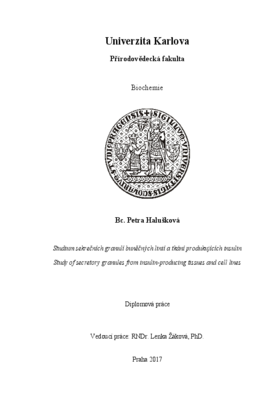Studium sekrečních granulí buněčných linií a tkání produkujících insulin.
Study of secretory granules from insulin-producing tissues and cell lines.
diplomová práce (OBHÁJENO)

Zobrazit/
Trvalý odkaz
http://hdl.handle.net/20.500.11956/79281Identifikátory
SIS: 170627
Kolekce
- Kvalifikační práce [19610]
Autor
Vedoucí práce
Oponent práce
Koblas, Tomáš
Fakulta / součást
Přírodovědecká fakulta
Obor
Biochemie
Katedra / ústav / klinika
Katedra biochemie
Datum obhajoby
22. 5. 2017
Nakladatel
Univerzita Karlova, Přírodovědecká fakultaJazyk
Čeština
Známka
Výborně
Klíčová slova (česky)
insulin, sekreční granule, isolace proteinů, beta-buňky, zinekKlíčová slova (anglicky)
insulin, secretory granules, protein isolation, beta-cells, zincSlinivka břišní (pankreas) je místem tvorby mnohých významných exokrinních a endokrinních látek, mezi které patří i insulin. Tento hormon je v těle tvořen téměř výhradně v specializovaných β-buňkách Langerhansových ostrůvků, kde je skladován v sekrečních granulích. β-buňky jsou plné těchto sekrečních váčků, čímž je umožněna rychlá reakce organismu na stimul glukosy. Správně upravený, zralý insulin se pravděpodobně vyskytuje v sekrečních granulích ve formě hexameru insulinu koordinovaném okolo dvou zinečnatých iontů. Adekvátní reakce β-buněk na zvýšenou hladinu glukosy v krvi a následná sekrece insulinu, jsou jedními z klíčových pochodů regulace metabolismu v těle. Při studiu tvorby insulinu, jeho účinků nebo procesu sekrece se mimo primárních buněk z pankreatických ostrůvků využívají jako biologický model permanentní pankreatické buněčné linie. Tato diplomová práce se zaměřila na buněčné linie INS-1E a BRIN-BD11. Zjišťovali jsme schopnost těchto buněk tvořit proinsulin a insulin a obsah jejich zinečnatých iontů, které mohou mít na tvorbu a zpracování insulinu velký vliv. Ve všech metodách, které jsme používali, jsme linie porovnávali navzájem a posléze také s β-buňkami potkaních Langerhansových ostrůvků. Také se nám podařilo izolovat insulinové sekreční granule ze všech tří používaných buněčných...
Pancreas is known to be an organ producing a variety of exocrine and endocrine substances, where also insulin belongs. This hormone is produced in the body almost solely by specialized β-cells of the Langerhans islets and is stored here in secretory granules. As the β-cells contain large number of these vesicles, an organism can quickly respond to the glucose stimulation. Completely processed insulin is formed in the secretory granules probably as a hexamer, where six insulin molecules are coordinated along two zinc bivalent cations. Appropriate β-cell response to higher glucose level and following insulin secretion is one of the key processes that regulate metabolism in the body. In order to study insulin production, its effects or secretion, permanent pancreatic cell lines are often used as biological models, out of primary cells from islets of Langerhans. This diploma thesis is focused on two permanent cell lines INS-1E and BRIN-BD11. We searched for the ability of the cells to produce insulin, if the hormone is fully processed, as well as zinc content, which could have a great influence on insulin's processing. Using different methods we compared these two cell lines with cells from the Langerhans islets. We succeeded in isolation of secretory granules from all three cell types and we plan to...
